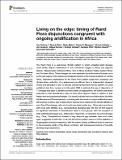Por favor, use este identificador para citar o enlazar a este item:
http://hdl.handle.net/10261/152810COMPARTIR / EXPORTAR:
 SHARE SHARE
 CORE
BASE CORE
BASE
|
|
| Visualizar otros formatos: MARC | Dublin Core | RDF | ORE | MODS | METS | DIDL | DATACITE | |

| Campo DC | Valor | Lengua/Idioma |
|---|---|---|
| dc.contributor.author | Pokorny, Lisa | es_ES |
| dc.contributor.author | Riina, Ricarda | es_ES |
| dc.contributor.author | Mairal, Mario | es_ES |
| dc.contributor.author | Culshaw, Victoria | es_ES |
| dc.contributor.author | Cendoya, Jon | es_ES |
| dc.contributor.author | Sanmartín, Isabel | es_ES |
| dc.date.accessioned | 2017-07-14T10:58:35Z | - |
| dc.date.available | 2017-07-14T10:58:35Z | - |
| dc.date.issued | 2015-05-01 | - |
| dc.identifier.citation | Frontiers in Genetics 6: 154 (2015) | es_ES |
| dc.identifier.issn | 1664-8021 | - |
| dc.identifier.uri | http://hdl.handle.net/10261/152810 | - |
| dc.description.abstract | The Rand Flora is a well-known floristic pattern in which unrelated plant lineages show similar disjunct distributions in the continental margins of Africa and adjacent islands—Macaronesia-northwest Africa, Horn of Africa-Southern Arabia, Eastern Africa, and Southern Africa. These lineages are now separated by environmental barriers such as the arid regions of the Sahara and Kalahari Deserts or the tropical lowlands of Central Africa. Alternative explanations for the Rand Flora pattern range from vicariance and climate-driven extinction of a widespread pan-African flora to independent dispersal events and speciation in situ. To provide a temporal framework for this pattern, we used published data from nuclear and chloroplast DNA to estimate the age of disjunction of 17 lineages that span 12 families and nine orders of angiosperms. We further used these estimates to infer diversification rates for Rand Flora disjunct clades in relation to their higher-level encompassing lineages. Our results indicate that most disjunctions fall within the Miocene and Pliocene periods, coinciding with the onset of a major aridification trend, still ongoing, in Africa. Age of disjunctions seemed to be related to the climatic affinities of each Rand Flora lineage, with sub-humid taxa dated earlier (e.g., Sideroxylon) and those with more xeric affinities (e.g., Campylanthus) diverging later. We did not find support for significant decreases in diversification rates in most groups, with the exception of older subtropical lineages (e.g., Sideroxylon, Hypericum, or Canarina), but some lineages (e.g., Cicer, Campylanthus) showed a long temporal gap between stem and crown ages, suggestive of extinction. In all, the Rand Flora pattern seems to fit the definition of biogeographic pseudocongruence, with the pattern arising at different times in response to the increasing aridity of the African continent, with interspersed periods of humidity allowing range expansions. | - |
| dc.description.sponsorship | This study was funded by the Spanish Ministry of Economy and Competitiveness (MINECO): Project AFFLORA, CGL2012-40129-C02-01 to IS. LP was funded by CSIC postdoctoral contract within AFFLORA. MH was funded by CGL2012-40129-C02-02, the Research Council of Norway (203822/E40) and a Ramón y Cajal Fellowship (RYC2009-04537). RR was supported by a JAE-DOC postdoctoral fellowship (MINECO) and the European Social Fund. MM and VC were supported by MINECO FPI predoctoral fellowships (BES-2010-037261 and BES-2013-065389 respectively). | - |
| dc.publisher | Frontiers Media | es_ES |
| dc.relation.isversionof | Publisher's version | - |
| dc.rights | openAccess | - |
| dc.title | Living on the edge: timing of Rand Flora disjunctions congruent with ongoing aridification in Africa | es_ES |
| dc.type | artículo | es_ES |
| dc.identifier.doi | 10.3389/fgene.2015.00154 | - |
| dc.description.peerreviewed | Peer reviewed | - |
| dc.relation.publisherversion | http://dx.doi.org/10.3389/fgene.2015.00154 | - |
| dc.date.updated | 2017-07-14T10:58:35Z | - |
| dc.description.version | Peer Reviewed | - |
| dc.language.rfc3066 | en | - |
| dc.rights.holder | Copyright © 2015 Pokorny, Riina, Mairal, Meseguer, Culshaw, Cendoya, Serrano, Carbajal, Ortiz, Heuertz and Sanmartín. | - |
| dc.rights.license | http://creativecommons.org/licenses/by/4.0/ | - |
| dc.contributor.funder | Ministerio de Economía y Competitividad (España) | - |
| dc.contributor.funder | Consejo Superior de Investigaciones Científicas (España) | - |
| dc.contributor.funder | Research Council of Norway | - |
| dc.relation.csic | Sí | es_ES |
| dc.identifier.funder | http://dx.doi.org/10.13039/501100003339 | es_ES |
| dc.identifier.funder | http://dx.doi.org/10.13039/501100003329 | es_ES |
| dc.identifier.pmid | 25983742 | - |
| dc.type.coar | http://purl.org/coar/resource_type/c_6501 | es_ES |
| item.openairetype | artículo | - |
| item.grantfulltext | open | - |
| item.cerifentitytype | Publications | - |
| item.openairecristype | http://purl.org/coar/resource_type/c_18cf | - |
| item.fulltext | With Fulltext | - |
| Aparece en las colecciones: | (INIA) Artículos (RJB) Artículos | |
Ficheros en este ítem:
| Fichero | Descripción | Tamaño | Formato | |
|---|---|---|---|---|
| Living on the edge.pdf | 2,45 MB | Adobe PDF |  Visualizar/Abrir |
CORE Recommender
PubMed Central
Citations
23
checked on 30-mar-2024
SCOPUSTM
Citations
79
checked on 18-abr-2024
WEB OF SCIENCETM
Citations
75
checked on 22-feb-2024
Page view(s)
339
checked on 19-abr-2024
Download(s)
280
checked on 19-abr-2024

